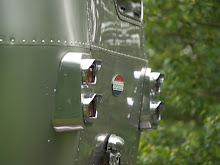After months of off and on work, grabbing five minutes here, an half an hour there--usually after cleaning up dinner dishes but before bed, I've finished restoring the vintage YOM (Year of Manufacture) license plate that we'll be using on the Cruisette. The background is in my 3/26/11 entry.
The Cruisette is old, and even when its restored, will still have that honest patina of 60 years on the road. I wanted the license plate to look better, but still reflect its age as well. I found lots of folks on the web who will restore vintage plates--usually for CRAZY money--but it always involves a strip to bare metal which would definitely atomize the ubercool 1952 registration decal. I'm sure it could be repopped, but that would be heading further away from my intentions to retain honest age.
I was able to retain virtually all of the original paint left on the plate and about 80-85% of what you see has been on it since 1951. Here's the before:
I used 0000 steel wool, ScotchBrite pads, and 800 grit wet/dry sandpaper to gently remove surface rust on the chips and scratches, and to give the existing surface some key for the new paint. I did a lot of custom mixing of the paints I used since the original colors had shifted over time--the blue to a deep, deep, almost black and the white to a cream/tan. I used Humbrol enamels since they have a better color selection at the local hobby store, they're made in Notchina, and they come in small metal paint cans which open with a small screwdriver, penknife, etc. I spent my childhood driven to madness trying to open bottles of Testor's paint with vises and pliers after the cap and bottle fuse with dried paint the second time you use them.
I'd never blended paint before to color match so I made sure to err on the side of "too light" for the first pass. For the letters I mixed white with a small amount of brown and a touch of yellow. The base color was dark blue further darkened with black. I chose flat paint to negate glare affecting my color matching.
Some of the keys to good results were: 1. using a very fine, high-quality (read expensive) camel brush, 2. using binocular magnifiers so you can see the work, and 3. Don't do ultra fine work more than 5-10 minutes at a time. Impatience and muscle fatigue caused the work to get sloppy.
I started by filling in the chips and scratches with distinct edges, letting the paint flow to fill in the damage. Multiple thin coats give the best results, and wet sanding lightly between coats removed any brush marks. Color matching the blue background paint ultimately required a wash of black paint and thinner in multiple passes with a borderline dry brush technique. The best color matching came from using bright indirect sunlight.
Once the color repairs were complete I sprayed multiple thin coats of Rust-oleum PaintPlus 2X Ultra Cover matte clearcoat to seal and protect the paint. It also made the paint reflectivity uniform.
In the end the process was very effective to achieve the result I was after: a good looking presentable plate that wears its 61 years proudly. Judge for yourself:
















